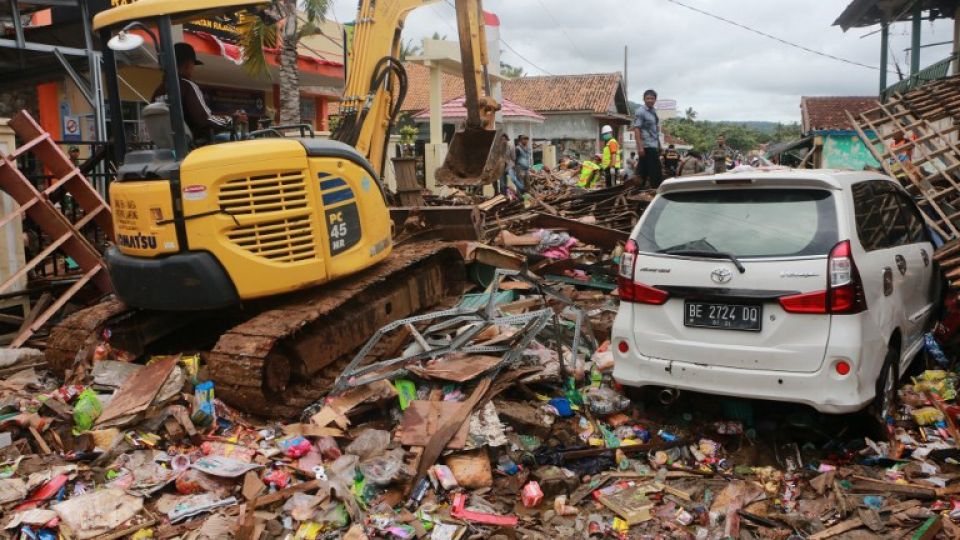December 24, 2018
A round up by the Jakarta Post of what we know so far about the deadly event.
A tsunami hit Banten and Lampung on Saturday at 9:27 p.m. The tsunami was caused by an abnormal tidal wave surge due to a full moon and an underwater landslide following the eruption of the Anak Krakatau volcano.
The tsunami reached as high as 3 meters, according to Rachmat Triyono, the head of the tsunami and earthquake division at the Meteorology, Climatology and Geophysics Agency (BMKG).
As of Sunday afternoon, the death toll reached 222, while 843 people were injured and 28 were missing. Many of those killed were tourists.
Pandeglang regency in Banten, a popular tourist destination, was the worst-hit area. Other regencies hit by the tsunami are Serang in Banten and South Lampung in Lampung. In the latter, the four worst-hit subdistricts are Kalianda, Rajabasa, Sidomulyo and Katibung.
Most Indonesians are currently on holiday, and both Banten and Lampung with their scenic beaches are popular tourist destinations. Tanjung Lesung in Pandeglang is one of 10 national tourist destinations specifically promoted by the Tourism Ministry under a program called the 10 New Balis.
Here is what we know so far about the Sunda Strait tsunami:
Increasing volcanic activity
Anak Krakatau is a small volcanic island located in the Sunda Strait, between the islands of Java and Sumatra. It emerged from the ocean half a century after Krakatau’s deadly eruption in 1883, hence the term anak (child) in its name.
Anak Krakatau has seen small regular eruptions since June. The volcano was put on the second-highest alert level – caution – in 2012.
Anak Krakatau is not the only volcano showing increasing activity.
The Volcanology and Geological Hazard Mitigation Center (PVMBG) announced earlier this week that 20 volcanoes in Indonesia had been showing above-average volcanic activity. The PVMBG had cautioned tourist management groups and local administrations, as volcanoes are popular tourist destinations.
Anak Krakatau is under 24-hour observation, along with Mount Sinabung and Mount Siputan, both in North Sumatra.
Bodies of victims recovered along Carita beach are placed in body bags on Sunday after the area was hit by a tsunami the night before following an eruption of the Anak Krakatau volcano. (AFP/Semi)
Tsunami or tidal wave?
Soon after the news of a tsunami broke, social media were flooded by debates over whether it was a tsunami or a tidal wave.
National Disaster Mitigation Agency (BNPB) spokesman Sutopo Purwo Nugroho initially said in a tweet that has since been deleted that Banten was hit by a tidal wave due to a full moon and not a tsunami, since no earthquake had been detected. However, the statement was revised in a press conference later in the evening, when the agency confirmed that a tsunami had indeed occurred.
A tsunami is generally understood as a tidal wave caused by an earthquake, hence the confusion.
Sutopo tweeted an aerial video on Sunday, showing the damage the tsunami wrought in Lampung coastal areas.
The eruption of Anak Krakatau has been attributed as the cause of the tsunami. However, the connection between the volcano and the tsunami is still being studied.
Stronger eruptions of Anak Krakatau in the past had not resulted in tsunamis, according to the PVMBG. In a press statement, the center stated that, to trigger a tsunami, there needed to be a massive landslide into the sea.
A tweet from the United Nations Population Funds of Asia Pacific, shows an infographic of how volcanic activity can cause a tsunami.
Tsunami expert Ahmad Muhari said there were two possible causes for the tsunami: a landslide caused by the Anak Krakatau eruption or a sudden change in meteorological conditions, but he added that both theories had their limitations.
Indonesian Geologists Association (IAGI) chairman Sukmandaru said that, based on currently available data, he felt an underwater landslide was the best explanation for the tsunami.
“The Anak Krakatau eruption probably caused a tremor that resulted in a landslide on an underwater slope that in turn triggered the tsunami,” he told the Post on Sunday.


